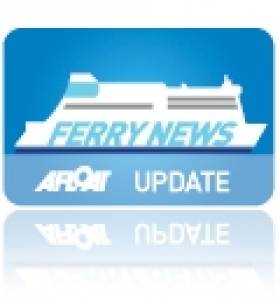Displaying items by tag: New Ferry Route
LD Lines Launch New UK-Spain Route
#NewROUTE – LD Lines has begun a new UK-Spain route between Poole, Dorset and Santander in Cantabria served by ro-pax Norman Asturias with a capacity for up to 500 passengers, 200 cars or 110 freight vehicles, writes Jehan Ashmore.
As of mid-afternoon today, the 27,414 tonnes ferry entered the western approaches of the English Channel having departed Spain yesterday at 18.00hrs and is due to dock in the Dorset port this evening at 19.00hrs.
Norman Asturias was deployed to the new twice weekly return operated route having been displaced from the St. Nazaire (Montoir-de-Bretagne)-Gijón route which is now operated by Scintu, a sister of the popular Visentini Italian built ro-pax design ferries. The French-Spain route is part of the EU's 'Motorways of the Sea (MOS) programme to divert traffic away from congested roads and transferring onto faster vessels (i.e. the ro-pax design).
The new 26-hour route represents a major development to LD Lines creation of an Atlantic ferry network, providing new links to serve the UK, French, Spanish and Portuguese freight. In addition catering for UK tourism markets and making regions such as the Algarve within easier reach.
To cover the long distance route, the 24-knot Norman Astuarias was deployed to the route. Among her sisters are Celtic Horizon and her predecessor on Celtic Link Ferries Rosslare-Cherbourg route the Norman Voyager. In mid-October she carried out berthing trials in Poole on behalf of her fleetmate.
LD Lines which is part of the Louis Dreyfus Group had tipped their toes into the Irish ferry market several years ago on the short-lived Rosslare-Le Havre operation. The service was only run at weekends as Norman Voyager also and remains running weekday sailings between the French port to Portsmouth.
The revival of the Rosslare route to Normandy had not been operated for many years when Irish Continental Group's (ICG) ferry division Irish Ferries ran the route served by St. Killian II until 1997. Following LD Lines departure from the Irish route, Celtic Link quickly seized a charter option of the 2008 built ferry until current route vessel Celtic Horizon came on the scene two years ago.
The introduction of LD Lines onto the Biscay run brings competition to long established operators Brittany Ferries whose services also run between Santander and the UK (Plymouth and Portsmouth). As previously reported on Afloat.ie, Brittany Ferries took over the Portsmouth-Bilbao route following P&O's exit of the Iberian service served by the former ICG owned Pride of Bilbao.
On another Irish related note the new LD Lines route will sharpen and focus minds again on previous calls to have a similar ro-pax operated service linking Ireland to Iberia.
As also reported, the Port of Cork has been actively involved in attempts to introduce such a service through the PROPPOSE partnership between the Irish port and Gijon.
Currently goods totalling 110,000 tonnes move between Ireland and Iberia by road via the UK and France with the consequent cost, environmental impact and susceptibility to French toll-roads. In addition that country's banning of HGV traffic at weekends and the planned implementation of Ecotax for trucks from 1 January 2014.






























































